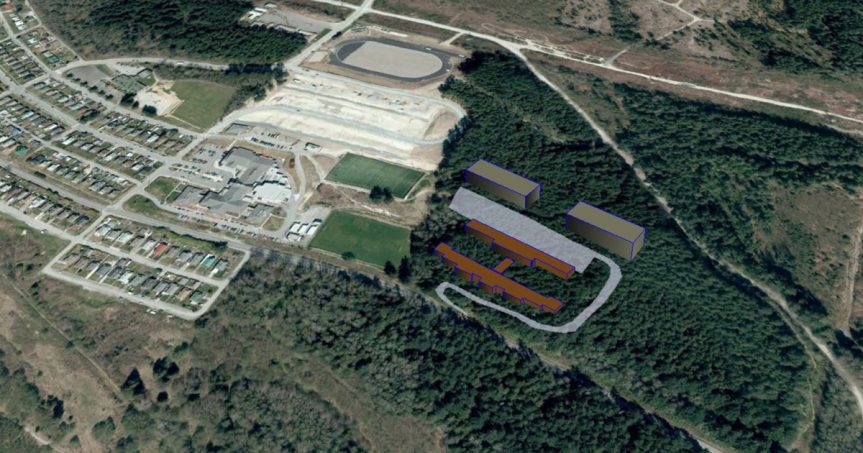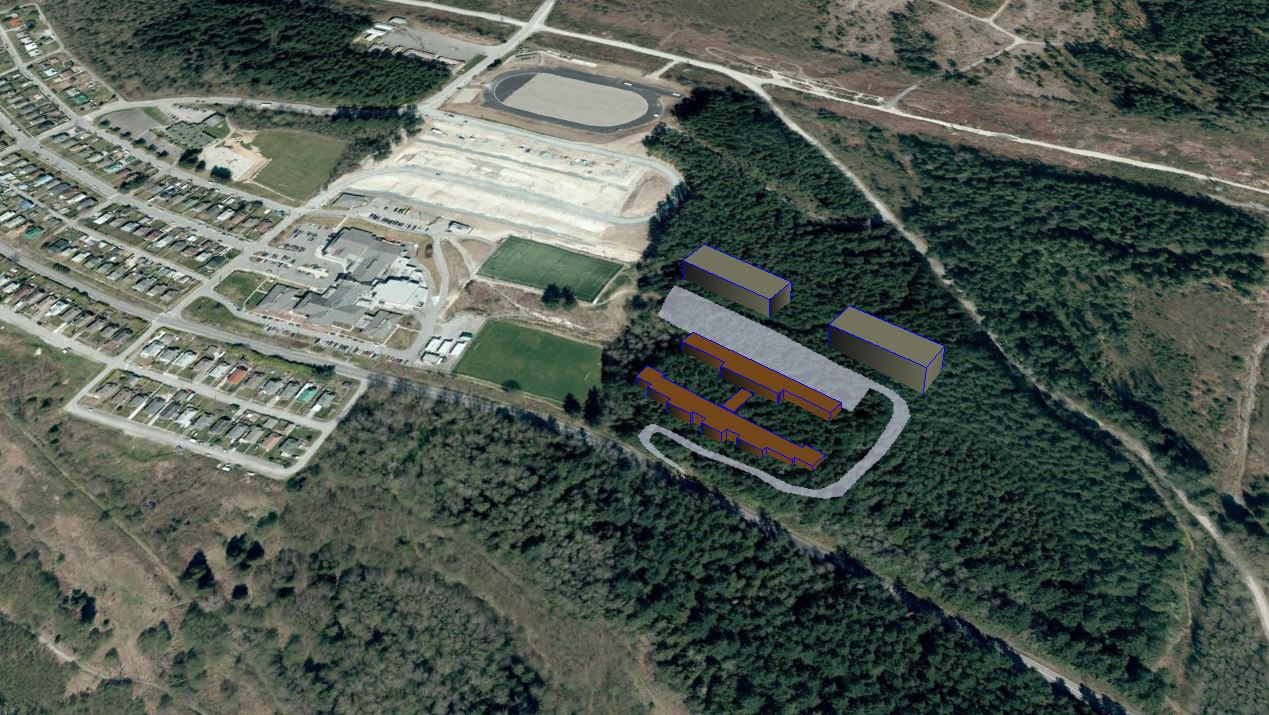
This image was created by georeferencing a map from a City planning document, and then creating a 3-D footprint in Google Earth.
I have no idea how high the school or dorm buildings would actually be, but the “footprint” is certainly “large” when compared to adjacent Brooks Secondary School.
Another ALR exclusion
As the ALC considers excluding 12.1 hectares (30 acres) from the ALR in order to accommodate Sino Bright school, I thought it might be useful to revisit the history of this and surrounding lands.
Some may be unaware that the proposed exclusion is part of what used to be a much larger ALR – and that this is not the first time these lands have come up for exclusion.
So far I’ve been unable to find an actual electronic or paper map of the 1975 ALR. So I had to work backwards, starting with a 2014 map that was available from the ALC. Then it became a matter of synthesizing information contained in government documents and old newspapers. Here’s what I’ve learned from the exercise.
The ALR in 1975

At time of designation in 1975, the ALR in central Powell River comprised a single parcel of about 200 hectares.
Landsat images from this period are of low resolution (30 m) by modern standards. They are, however, sufficient to show absence of large-scale forest harvesting. The “pole line” is clearly visible, and the “haul road” barely so.
Most of the standing timber was approaching 40-60 years of age, representing 2nd growth after earlier logging and the great fire of 1923.
The 1994 Exclusion
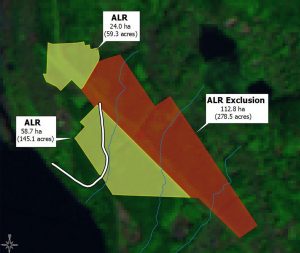
The first major change occurred in 1994, when a private landowner (MacMillan Bloedel Ltd) applied for exclusion of 112.75 hectares. MacMillan Bloedel was owner of the mill and substantial other properties at the time.
At that time private landowners were allowed to apply for exclusion of their own land, provided they secured the support of local government.
Although ALR staff recommended refusal, the application was endorsed by Powell River City Council, citing “community need”. The applicant envisioned light industrial and residential development, with a “buffer” between the two along McFall Creek.
Both the maps and decision are worth studying in full. The letter confirming exclusion is dated 12 May 1994. Apparently the discussion took some time, and was not without debate. I note the language of the decision, which states, in part:
“While the Commission is reluctant to grant unconditional approval of the exclusion of these lands, it is confident that planning for the future uses of the property will be such that there will be no need for additional ALR lands to satisfy the growth requirements of the community in the foreseeable future.”
The Yrainucep proposal
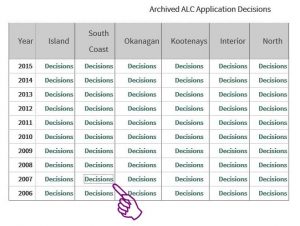
The September decision is missing…
The next major event came in 2006 with the strangely-named “Yrainucep” (pecuniary spelled backwards) proposal. I’ve so far been unable to obtain a copy of either the application or the decision that was released on 24 Sept 2007.
The decision is missing from where I would have expected to find it on the ALC’s otherwise excellent web-based archive of decisions. However, according to an earlier article in the Powell River Peak (21 June 2007):
“The city has applied to the ALC to remove five parcels containing 245-hectares from the agricultural land reserve in order to create economic development and diversify the tax base. Madrone Environmental Services Ltd. reported on the land capability for 352-hectares of the property, which it divided into three distinct areas: Area 1, 284-hectares, located north of Powell River in the Wildwood area; Area 2, 13-hectares, located along Cranberry Street and the BC Hydro power line; and Area 3, 55-hectares, located between the Townsite and Westview.”
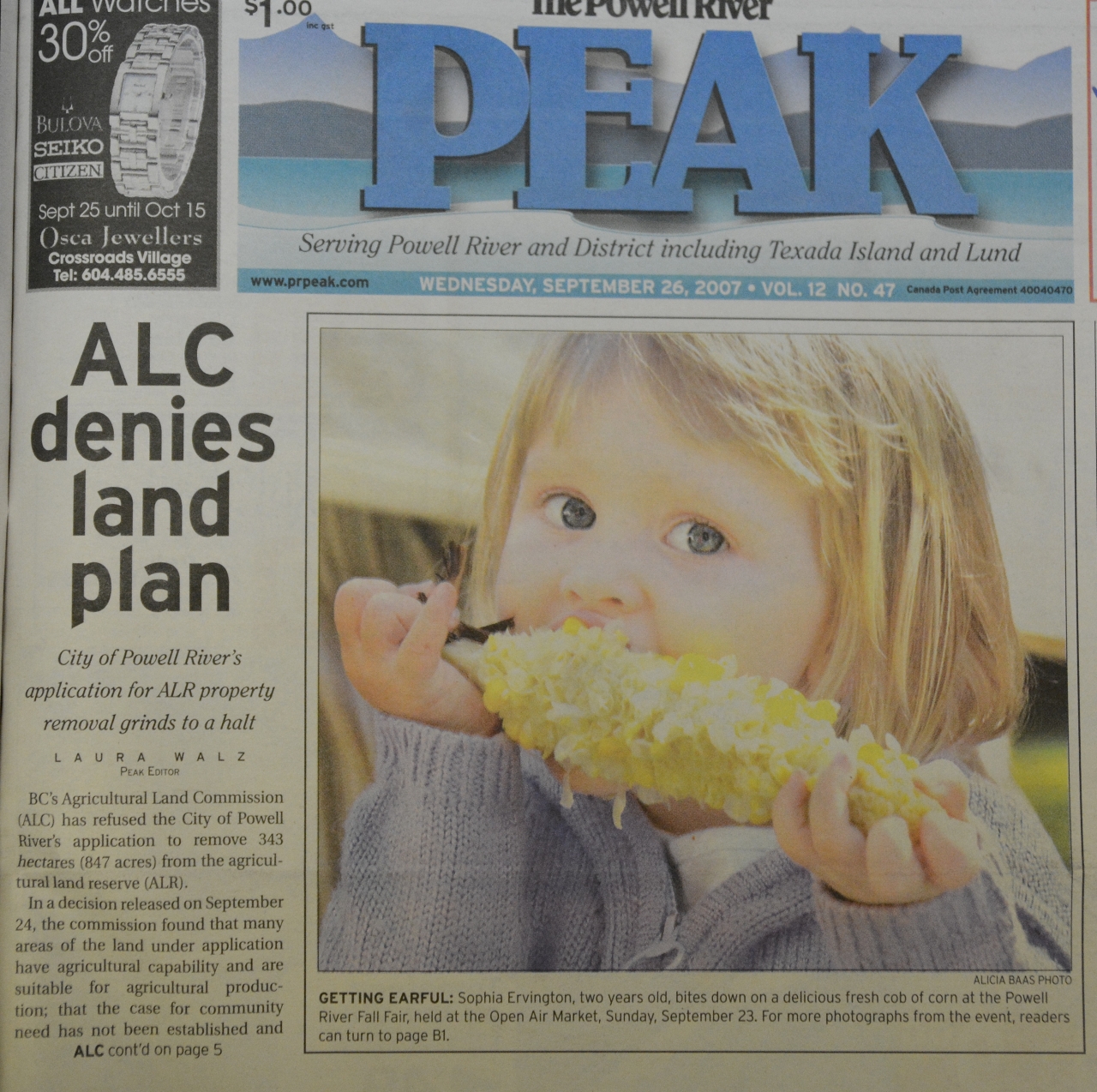
click on the picture to read the article.
This ultimately proved to be a “non-event” in terms of the ALR, because the Commission flatly refused the application. Again according to the Powell River Peak (26 Sept 2007), the Commission remained concerned about a number of issues, including:
- loss of agricultural land, much of which, with improvements, was considered suitable for agriculture
- absence of details about the proposed development, or the degree to which that would address community needs
- lack of an inventory of the land base in Powell River, and
- that lands excuded from the ALR in 1994 for economic development reasons remained undeveloped.
I’m still trying to clarify some of the details, but note that the application included the Sino Bright parcel presently under consideration. In any event, Yrainucup did not proceed and nothing happened to the ALR.
UPDATE [27 Dec 2016]: The missing ALC decision and relevant maps have now been found – thanks to a careful reader and diligent record-keeper – Thank you!
The 2009 ALR subdivision of Lot “A”

Fast forward to 2009, which saw another ALR application – one that few probably noticed, and fewer still would have considered important. This was the application to sub-divide the southern portion of the remaining ALR.
The intent in this case was to permit the legal acquisition of what is now known as Upper Millennium Park.
Presumably a subdivided ALR was also an essential step towards making lands to the west of the park available for sale or consideration of other developments.

In retrospect, it might have been easier to keep this treasure had the entire area been maintained as ALR.
The long-held dream to create Millennium Park, born of a few people in the late 1990s, was finalized in early 2015 with the purchase of trees from Island Timberlands (who still own, I hasten to add, harvest rights for standing timber on the rest of the ALR).
Note that Island Timberlands also owns, lock, stock and barrel, the former ALR to the northeast that is now Private Managed Forest Land (PMFL)…
…and that Millennium Park wound up being just a tad smaller than the dreamers dreamed.
The Sino Bright proposal
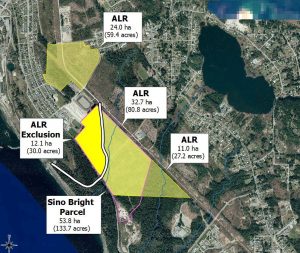
At last we come to the present (2016) application for exclusion. Here we see the ALR that remains in Millennium Park, and also the adjacent “Sino Bright” land parcel of 54 ha (134 acres), some of which is outside the ALR.
The 12.1 ha (30 acres) proposed for exclusion are highlighted in bright yellow.
Details of the proposed Sino Bright private school remain sketchy, although some relevant planning documents are available here and here. The job-creation prospects are both enticing – and similarly devoid of detail.
I scanned and geo-referenced a paper map of the proposed Sino Bright school footprint. It’s not small. Excluding roads and parking lots, the building area is similar to that of the adjacent Brooks Secondary School. It also occupies a large fraction of the proposed exclusion area.
I did the same for the Madrone Environmental Services soil capability mapping done in 2007 in support of the Yrainucep proposal. The full report can be found here. Together the two maps offer some additional perspective about the impacts, both visual and otherwise.
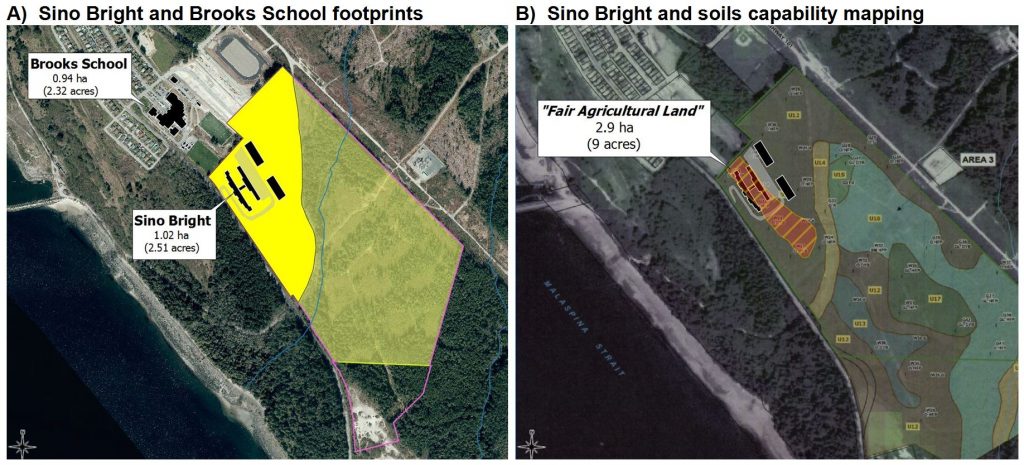
Map B shows soil characteristics as mapped by Madrone in 2007 – the 2.9 ha area of “fair agricultural land” is highlighted (hatched). One can easily appreciate how leaving that area as ALR (as City staff recommended on 17 May 2016) would have made things, well, difficult for the developer…
One big question
For me, one major question remains unaddressed, although it has been been asked repeatedly, for example here and here.
“Why does Sino Bright have to be built there? ”
It’s not my place to 2nd guess the engineers or urban planners, but I can think of at least a couple of other possible locations, one of which is the former ALR owned by Island Timberlands, the other of which is owned by the same landowner (PRSC) that owns the Sino Bright parcel…

Personally, I think the old golf course would provide better views…

